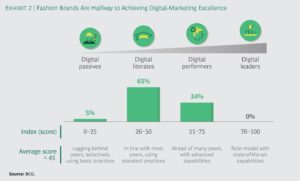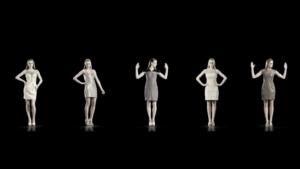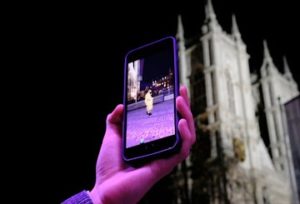Virtual Revolution: Crucial Digital Strategies Driving The Post-Pandemic Luxury & Fashion Industry
Covid-19 has presented numerous challenges for the luxury fashion industry. Fashion industry revenues are on pace to contract by nearly 30% worldwide in 2020. Despite the current situation, growth opportunities are attainable. Luxager advises brands to focus on sustainability, E-Commerce, digital and virtual fashion. We believe these emerging strategies will position brands for success in the post-pandemic fashion industry.
Fashion Industry Reform
The delay of 2020 Fall and Summer collection deliveries, resulting from COVID-19, put a spotlight on vulnerable aspects of the fashion industry and drove improvement efforts by top industry leaders. Launched May 12th and 14th, 2020, two initiatives called for large-scale changes to the fashion calendar, a re-thinking of fashion shows, and different discounting practices. The proposals hope to align seasonal collections with their actual corresponding seasons, in addition to creating “greener” supply chains. The May 12 Open Letter to the Fashion Industry had the specific sustainability goals of having “less unnecessary product”, “less waste in fabrics and inventory”, and “less travel” in the supply chain and sales calendar. The plans also aimed to make outdated fashion shows more customer-centric in order to boost demand for collections. They hope to eliminate rigid rules for the format of shows and allow designers to use more imagination in presenting their collections. Finally, mid-season sales were to be eradicated with discounting only occurring at season’s end. As a whole, the pandemic has made customers more conscious of the products they buy. While discounts certainly will continue to play a major role, they have taken a back-seat to sustainability for many customers making the buying decision. Nastasia (Cornell University), from our Marketing Strategy team at Luxager Studio, is optimistic of the proposals, claiming “I believe these initiatives will soften the blow and make the industry more productive in its recovery period.”
The Online Fashion Revolution
We see a shift, accelerated by the pandemic, from brick and mortar stores to online platforms. According to BCG, E-commerce is growing three times quicker than in-person shopping and expected to comprise a quarter of all Western Europe fashion sales by 2020. Most fashion brands are far from achieving digital marketing excellence and missing a key ingredient for post-pandemic growth. An expanded and strengthened online presence can earn fashion brands an expected 15% increase in revenues. “The pandemic has proven how brands adapted to digital channels are more likely to thrive under extreme circumstances like the one this year” noted Andrew (The Wharton School), from our Marketing Strategy team at Luxager Studio. An additional E-Commerce trend that brands must be conscious of is the rapid growth of online marketplaces, which are outpacing brand-owned websites. Despite sales between the two being relatively even at present, online marketplaces will soon host the majority of fashion E-Commerce sales, as they are growing 4% faster than brand-owned sites. To ensure growth, Fashion Brands must not only sell through their own websites, but through larger online marketplaces as well.
Digital and virtual fashion will become commonplace in a substantially redefined fashion industry. Digitalization will be implemented through the entire fashion cycle from the supply chain to the showcasing and retailing processes. Online fashion weeks and shows, new collections showcasing on social media, and live-streams and videos exhibiting new looks are beginning to be utilized by brands. London Fashion Week and Shanghai Fashion Week are two examples of high-profile shows moving online in 2020. Digital platforms are quickly becoming the main marketing battleground for fashion brands. In 2019, money spent on digital ads has surpassed that of non-digital ads. Digital marketing spending will only increase in the coming years, as BCG found about 95% fashion brands are planning considerable increases in online media spending. We understand the potential of digital fashion at Luxager Studio and urge brands to utilize it as a strategy.
The need to adapt to an ever changing world has left many companies with questions on what to do next. The skill that is clearly becoming the most important one is adaptability. Firms need to be able to be flexible not only in their products, but in their use of their infrastructure and tools. For instance, e-commerce could be the defining characteristic of this time. Project managers here at Luxager Studio are working to incorporate e-commerce into the way our clients’ brands operate.
Luxager Studio is also committed to easing some of the stress that our clients and followers are facing right now. According to our Social Media team at Luxager Studio: “We as a team are focusing on engagement with our followers and trying to give people a chance to express their opinion on certain trends/pieces. We hope that our content doesn’t only educate our followers but also provides them with some sort of entertainment during this stressful time”.

Five vulnerable areas of the fashion industry to COVID-19 that require innovative strategies

Most fashion brands are merely digitally literate, not excellent.
The Rise of Virtual Technologies
Technologies seemingly fit for Sci-Fi movies are now on the verge of an industry-disrupting breakthrough. Augmented and virtual reality technologies will allow retailers to create innovative and futuristic store concepts. Through filters, consumers now can see how clothing products look on them through their smartphones before making the purchasing decision. 3D designs and virtual showrooms also are in their infancy and have enormous growth potential. Customers can create and view products digitally and will have the ability to spend more time with designs, in greater detail, as images of models can be rotated 360 degrees. The benefits of allowing customers to see designs in greater detail digitally, has already paid off for some companies. Online wholesale platform Joor, which utilizes virtual showrooms, had average order totals increase by a factor of four from the past year. Virtual runways and fashion shows could be performed live on any smartphone through augmented reality or presented by brands to large audiences in multiple venues simultaneously through holograms. The former technology is much closer to reality and has already been demonstrated. There are numerous possibilities for its use, but the fashion industry will likely use augmented reality to layer images of models into the background of the viewer’s phone screen. Holograms are more difficult to actualize, but have been used already in the music industry and on a few occasions in the fashion industry. The ability to project images of models at larger sizes will certainly make fashion shows a greater spectacle and drive more excitement to the industry.


Steven Eckhart’s Fashion Show, the world’s first 3D holographic fashion show, in Hamburg in March, 2011

Augmented reality fashion show at London Fashion Week, created by London College of Fashion’s Innovation Agency in collaboration with HoloMe.
About the Authors –
Our founder ATHÉNA, and Luxager Studio’s Financial Strategists from Boston College and Tufts University.
About Luxager Studio’s Brand Services –
We provide futuristic content production and brand partnership services, helping businesses raise brand awareness and achieve higher performance. If you are looking to grow and innovate your brand, click here to check out Luxager Studio’s offerings for brands: Brand Boardroom Program.



Recent Comments